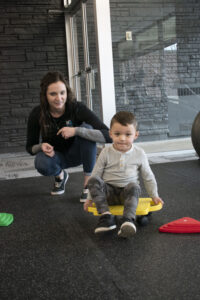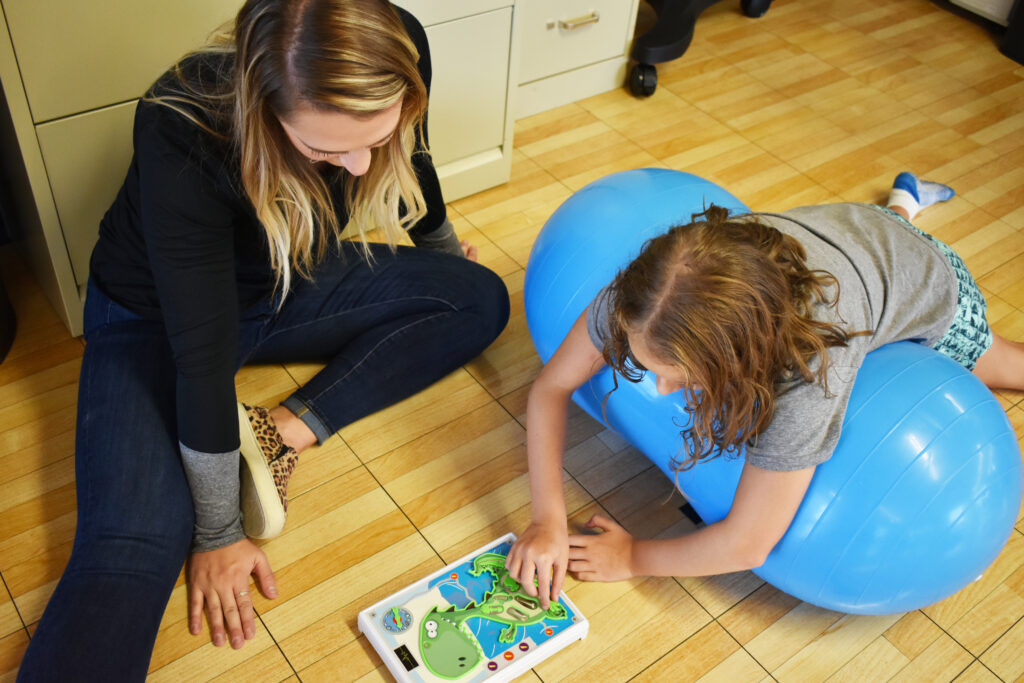As parents and caregivers, we want the best for our children’s physical and cognitive development. We strive to provide them with opportunities that promote growth and learning. One often overlooked aspect of a child’s development is the ability to perform “midline crossing” tasks. Midline crossing tasks are activities that involve moving one hand, foot, or eye across the body’s midline, which divides the body into left and right halves. Incorporating these tasks into your child’s daily routine can have a profound impact on their development, and as a physical therapist, I am here to explain why.
Strengthening Brain Connectivity:
Midline crossing tasks help strengthen the neural connections between the two hemispheres of the brain. This enhanced connectivity is crucial for various cognitive functions, including problem-solving, reading, writing, and math skills. When a child crosses the midline, they engage both sides of their brain, fostering better communication and coordination between them.
Improved Bilateral Coordination:
Midline crossing tasks encourage the use of both sides of the body simultaneously. This promotes bilateral coordination, essential for activities like tying shoelaces, riding a bike, and playing sports. Developing strong bilateral coordination early in life lays a solid foundation for success in various physical activities.

Enhanced Fine Motor Skills:
Fine motor skills involve the precise control of small muscles in the hands and fingers. Many activities that require crossing midline, such as drawing shapes, cutting with scissors, or picking up small objects, help refine these fine motor skills. In addition, it is important for eyes to cross midline while eye teaming to be effective in reading, writing, and buttoning clothing.
Better Spatial Awareness:
Midline crossing tasks enhance a child’s spatial awareness and perception. They learn to understand their body’s position in space, which is valuable for activities like navigating crowded spaces, participating in team sports, and even dancing. Improved spatial awareness contributes to overall physical confidence.
Language Development:
Surprisingly, midline crossing tasks can also positively impact language development. The coordination and brain connectivity fostered by these tasks can lead to improved communication skills, including better articulation, vocabulary, and understanding of language concepts.
Enhanced Concentration and Focus:
Engaging in activities that require crossing the midline can help children improve concentration and focus. They learn to coordinate their movements and stay engaged in tasks for more extended periods, which is beneficial for both academic and recreational pursuits. When our brain is able to communicate effectively between hemispheres it doesn’t have to work as hard to function against gravity, leaving more mental energy to problem-solve, attend to, and regulate emotions and impulses.
Social Benefits:
Participating in group activities that involve crossing midline, such as team sports or dance classes, can improve a child’s social skills. They learn to cooperate, follow instructions, and communicate effectively with their peers while enjoying physical activity.

Incorporating Midline Crossing Tasks:
Now that we understand the importance of midline crossing tasks in a child’s development, the next question is how to incorporate these activities into their daily routine:
Encourage play: Provide toys and games involving reaching the midline, such as building blocks, puzzles, or drawing with chalk.
Enroll in organized activities: Consider enrolling your child in sports like soccer, tennis, or dance, where midline crossing movements are an integral part of the game.
Be creative: Encourage your child to explore their creativity through art and crafts activities that require crossing the midline, like cutting and pasting.
Practice at home: Incorporate simple exercises into your daily routine, such as reaching across the midline while sitting or standing. Make it fun and engaging.\
Midline Crossing Tasks Are Crucial
Midline crossing tasks are more than just physical activities; they are building blocks for a child’s overall development. Incorporating these tasks into your child’s daily routine can help them build a strong foundation for cognitive, physical, and social success. As a physical therapist, I highly recommend embracing these activities as part of your child’s growth journey. It’s a simple yet effective way to support their development and set them on the path to a bright future.
If you have any questions or concerns about your child’s development reach out to us today at 866-588-0230 or schedule a free screen online!



